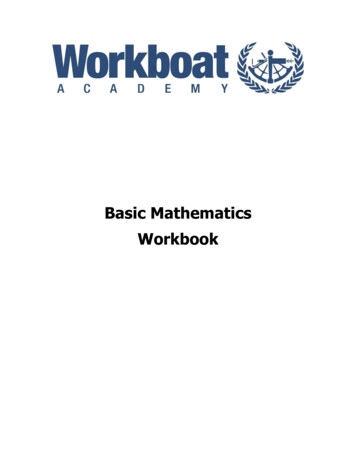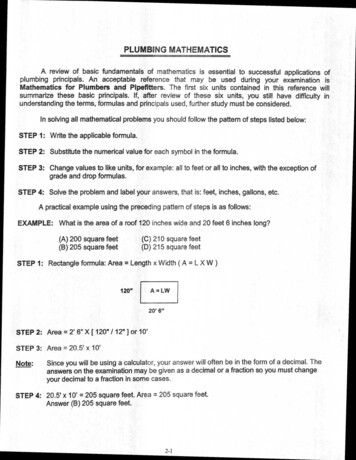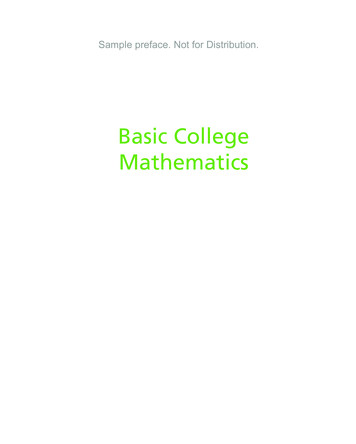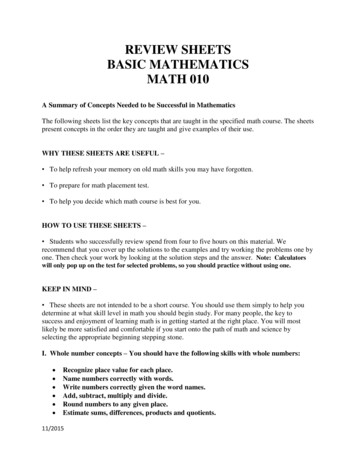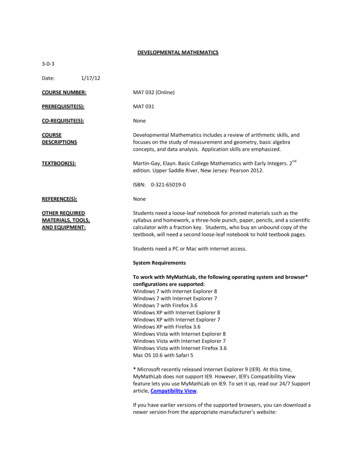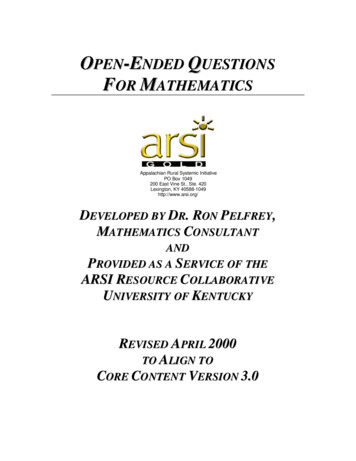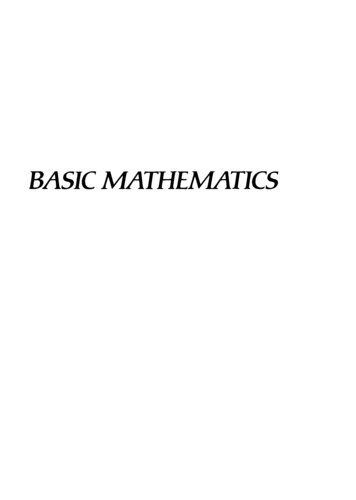
Transcription
BASIC MATHEMATICS
SERGE LANGColumbia UniversityBASIC MATHEMATICSATTADDISON -WESLEY PUBLISHING COMPANYReading, MassachusettsMenlo Park, California London Don Mills, Ontario
This book is in theADDISON-WESLEY SERIES IN INTRODUCTORY MATHEMATICSConsulting Editors:Gail S. YoungRichard S. PietersCover photograph by courtesy of Spencer-Phillips and Green, Kentfield, California.Copyright 1971 by Addison-Wesley Publishing Company Inc. Philippines copy right 1971 by Addison-Wesley Publishing Company, Inc.All rights reserved. No part of this publication may be reproduced, stored in aretrieval system, or transmitted, in any form or by any means, electronic,mechanical, photocopying, recording, or otherwise, without the prior written per mission of the publisher. Printed in the United States of America. Publishedsimultaneously in Canada. Library of Congress Catalog Card No. 75-132055.
To Jerry
M y publishers, Addison-Wesley, have producedmy books for these last eight years. I want itknown how much I appreciate their extraordi nary performance at all levels. General editorialadvice, specific editing of the manuscripts, andessentially flawless typesetting and proof sheets.It is very gratifying to have found such a com pany to deal with.New York, 1970
AcknowledgmentsIam grateful to Peter Lerch, Gene Murrow, Dick Pieters, and Gail Young for theircareful reading of the manuscript and theiruseful suggestions.Iam also indebted to Howard Dolinsky,Bernard Duflos, and Arvin Levine for workingout the answers to the exercises.S.L.
ForewordThe present book is intended as a text in basic mathematics. As such,it can have multiple use: for a one-year course in the high schools during thethird or fourth year (if possible the third, so that calculus can be takenduring the fourth year); for a complementary reference in earlier high schoolgrades (elementary algebra and geometry are covered); for a one-semestercourse at the college level, to review or to get a firm foundation in the basicmathematics necessary to go ahead in calculus, linear algebra, or other topics.Years ago, the colleges used to give courses in “ college algebra” andother subjects which should have been covered in high school. More recently,such courses have been thought unnecessary, but some experiences I have hadshow that they are just as necessary as ever. What is happening is that thecolleges are getting a wide variety of students from high schools, rangingfrom exceedingly well-prepared ones who have had a good first course incalculus, down to very poorly prepared ones. This latter group includes bothadults who return to college after several years’ absence in order to improvetheir technical education, and students from the high schools who were notadequately taught. This is the reason why some material properly belongingto the high-school level must still be offered in the colleges.The topics in this book are covered in such a way as to bring out clearlyall the important points which are used afterwards in higher mathematics.I think it is important not to separate arbitrarily in different courses thevarious topics which involve both algebra and geometry. Analytic geometryand vector geometry should be considered simultaneously with algebra andplane geometry, as natural continuations of these. I think it is much morevaluable to go into these topics, especially vector geometry, rather than togo endlessly into more and more refined results concerning triangles ortrigonometry, involving more and more complicated technique. A minimumof basic techniques must of course be acquired, but it is better to extend thesetechniques by applying them to new situations in which they becomeix
XFOREW ORDmotivated, especially when the possible topics are as attractive as vectorgeometry.In fact, for many years college courses in physics and engineering havefaced serious drawbacks in scheduling because they need simultaneouslysome calculus and also some vector geometry. It is very unfortunate that themost basic operations on vectors are introduced at present only in college.They should appear at least as early as the second year of high school. Icannot write here a text for elementary geometry (although to some extentthe parts on intuitive geometry almost constitute such a text), but I hopethat the present book will provide considerable impetus to lower considerablythe level at which vectors are introduced. Within some foreseeable future,the topics covered in this book should in fact be the standard topics for thesecond year of high school, so that the third and fourth years can be devotedto calculus and linear algebra.If only preparatory material for calculus is needed, many portions ofthis book can be omitted, and attention should be directed to the rules ofarithmetic, linear equations (Chapter 2), quadratic equations (Chapter 4),coordinates (the first three sections of Chapter 8), trigonometry (Chapter 11),some analytic geometry (Chapter 12), a simple discussion of functions(Chapter 13), and induction (Chapter 16, §1). The other parts of the bookcan be omitted. Of course, the more preparation a student has, the moreeasily he will go through more advanced topics.“ More preparation” , however, does not mean an accumulation of technicalmaterial in which the basic ideas of a subject are completely drowned. I amalways disturbed at seeing endless chains of theorems, most of them of nointerest, and without any stress on the main points. As a result, students donot remember the essential features of the subject. I am fully aware thatbecause of the pruning I have done, many will accuse me of not going “ deeplyenough” into some subjects. I am quite ready to confront them on that.Besides, as I prune some technical and inessential parts of one topic, I amable to include the essential parts of another topic which would not otherwisebe covered. For instance, what better practice is there with negative numbersthan to introduce at once coordinates in the plane as a pair of numbers, andthen deal with the addition and subtraction of such pairs, componentwise?This introduction could be made as early as the fourth grade, using maps asa motivation. One could do roughly what I have done here in Chapter 8, §1,Chapter 9, §1, and the beginning of Chapter 9, §2 (addition of pairs of numbers,and the geometric interpretation in terms of a parallelogram). At such alevel, one can then leave it at that.The same remark applies to the study of this book. The above-mentionedsections can be covered very early, at the same time that you study numbers
FOREW O RDxiand operations with numbers. They give a very nice geometric flavor to aslightly dry algebraic theory.Generally speaking, I hope to induce teachers to leave well enough alone,and to avoid torturing a topic to death. It is easier to advance in one topicby going ahead with the more elementary parts of another topic, where thefirst one is applied. The brain much prefers to work that way, rather than toconcentrate on ugly technical formulas which are obviously unrelated toanything except artificial drilling. Of course, some rote drilling is necessary.The problem is how to strike a balance. Do not regard some lists of exercisesas too short. Rather, realize that practice for some notion may come againlater in conjunction with another notion. Thus practice with square rootscomes not only in the section where they are defined, but also later when thenotion of distance between points is discussed, and then in a context where itis more interesting to deal with them. The same principle applies throughoutthe book.The Interlude on logic and mathematical expression can be read also asan introduction to the book. Because of various examples I put there, andbecause we are already going through a Foreword, I have chosen to place itphysically somewhat later. Take a look at it now, and go back to it wheneveryou feel the need for such general discussions. Mainly, I would like to makeyou feel more relaxed in your contact with mathematics than is usually thecase. I want to stimulate thought, and do away with the general uptightfeelings which people often have about math. If, for instance, you feel thatany chapter gets too involved for you, then skip that part until you feel theneed for it, and look at another part of the book. In many cases, you don’tnecessarily need an earlier part to understand a later one. In most cases, theimportant thing is to have understood the basic concepts and definitions, to beat ease with the simpler computational aspects of these concepts, and then togo ahead with a more advanced topic.This advice also applies to the book as a whole. If you find that there isnot enough material in this book to occupy you for a whole year, then startstudying calculus or possibly linear algebra.The book deals with mathematics on both the manipulative (or computa tional) level and the theoretical level. You must realize that a mastery ofmathematics involves both levels, although your tastes may direct you morestrongly to one or the other, or both. Here again, you may wish to vary theemphasis which you place on them, according to your needs or your taste.Be warned that deficiency at either level can ultimately hinder you in yourwork. Independently of need, however, it should be a source of pleasure tounderstand why a mathematical result is true, i.e. to understand its proof aswell as to understand how to use the result in concrete circumstances.
x iiFO REW ORDTry to rely on yourself, and try to develop a trust in your own judgment.There is no “ right” way to do things. Tastes differ, and this book is notmeant to suppress yours. It is meant to propose some basic mathematicaltopics, according to my taste. If I am successful, you will agree with mytaste, or you will have developed your own.New YorkJanuary 1971S.L.
ContentsPART IChapter 1ALGEBRANumbers1 The integers. . . .2 Rules for addition . . . . .3 Rules for multiplication . . . .4 Even and odd integers; divisibility .5 Rational numbers . . . . .6 Multiplicative inverses . . .Chapter 2Linear Equations1 Equations in two unknowns .2 Equations in three unknownsChapter 3Interlude12345357Real Numbers1 Addition and multiplication .2 Real numbers: positivity .3 Powers and roots . . . .4 Inequalities.Chapter 45814222642Quadratic Equations .6164707583On Logic and Mathematical ExpressionsOn reading books .Logic. . . .Sets and elements .Notation939499100x iii
XIVCONTENTSPART IIChapter 5INTUITIVE GEOMETRYDistance and Angles1 Distance2 A n g le s .3 The Pythagoras theorem .Chapter 6123456Chapter 7IsometriesSome standard mappings of the plane .Isom etries.Composition of isometries. . . .Inverse of isom etries.Characterization of isometries. . . .CongruencesChapter 8Coordinates and Geometry1234Chapter 111234191197203206Operations on Points1 Dilations and reflections.2 Addition, subtraction, and the parallelogram law .Chapter 10173180COORDINATE GEOMETRY1 Coordinate systems2 Distance between points .3 Equation of a circle4 Rational points on a circleChapter 9133143150155163166Area and Applications.1 Area of a disc of radius r . . .2 Circumference of a circle of radius rPART III107110120213218Segments, Rays, and LinesSegmentsRays. . .L i n e s .Ordinary equation for a line .229231236246TrigonometryRadian measureSine and cosine.The graphs .The tangent249252264266
CONTENTSAddition formulas .RotationsXV272277Some Analytic GeometryThe straight line againThe parabolaThe ellipse . . . .The hyperbola .Rotation of inition of a functionPolynomial functions .Graphs of functionsExponential function .Logarithms313318330333338MappingsDefinition . . . .Formalism of mappingsPermutations345351359Complex NumbersThe complex planePolar form .375380Induction and SummationsInductionSummationsGeometric series383388396DeterminantsM a t r i c e s .Determinants of order 2 .Properties of 2 X 2 determinantsDeterminants of order 3 .Properties of 3 X 3 determinantsCramer’s Rule . . . .401406409414418424Index429
Part OneALGEBRA
In this part we develop systematically the rules for operations with num bers, relations among numbers, and properties of these operations andrelations: addition, multiplication, inequalities, positivity, square roots, n-throots. We find many of them, like commutativity and associativity, whichrecur frequently in mathematics and apply to other objects. They apply tocomplex numbers, but also to functions or mappings (in this case, commuta tivity does not hold in general and it is always an interesting problem todetermine when it does hold).Even when we study geometry afterwards, the rules of algebra are stillused, say to compute areas, lengths, etc., which associate numbers withgeometric objects. Thus does algebra mix with geometry.The main point of this chapter is to condition you to have efficientreflexes in handling addition, multiplication, and division of numbers. Thereare many rules for these operations, and the extent to which we choose toassume some, and prove others from the assumed ones, is determined byseveral factors. We wish to assume those rules which are most basic, andassume enough of them so that the proofs of the others are simple. It alsoturns out that those which we do assume occur in many contexts in mathe matics, so that whenever we meet a situation where they arise, then wealready have the training to apply them and use them. Both historicalexperience and personal experience have gone into the selection of these rulesand the order of the list in which they are given. To some extent, you musttrust that it is valuable to have fast reflexes when dealing with associativity,commutativity, distributivity, cross-multiplication, and the like, if you donot have the intuition yourself which makes such trust unnecessary. Further more, the long list of the rules governing the above operations should be takenin the spirit of a description of how numbers behave.It may be that you are already reasonably familiar with the operationsbetween numbers. In that case, omit the first chapter entirely, and go right3
4ALG EB RAahead to Chapter 2, or start with the geometry or with the study of coordinatesin Chapter 7. The whole first part on algebra is much more dry than the restof the book, and it is good to motivate this algebra through geometry. Onthe other hand, your brain should also have quick reflexes when faced with asimple problem involving two linear equations or a quadratic equation.Hence it is a good idea to have isolated these topics in special sections in thebook for easy reference.In organizing the properties of numbers, I have found it best to looksuccessively at the integers, rational numbers, and real numbers, at the costof slight repetitions. There are several reasons for this. First, it is a good wayof learning certain rules and their consequences in a special context (e.g.associativity and commutativity in the context of integers), and then observ ing that they hold in more general contexts. This sort of thing happens veryfrequently in mathematics. Second, the rational numbers provide a wide classof numbers which are used in computations, and the manipulation of fractionsthus deserves special emphasis. Third, to follow the sequence integersrational numbers-real numbers already plants in your mind a pattern whichyou will encounter again in mathematics. This pattern is related to the exten sion of one system of objects to a larger system, in which more equations canbe solved than in the smaller system. For instance, the equation 2x 3 canbe solved in the rational numbers, but not in the integers. The equationsx2 2 or 10x 2 can be solved in the real numbers but not in the rationalnumbers. Similarly, the equations x2 —1, or x2 —2, or 10x —3 canbe solved in the complex numbers but not in the real numbers. It will beuseful to you to have met the idea of extending mathematical systems at thisvery basic stage because it exhibits features in common with those in moreadvanced contexts.
1 Numbersgl. THE INTEGERSThe most common numbers are those used for counting, namely thenumbers1, 2, 3, 4,,which are called the positive integers. Even for counting, we need at leastone other number, namely,0 (zero).For instance, we may wish to count the number of right answers you mayget on a test for this course, out of a possible 100. If you get 100, then allyour answers were correct. If you get 0, then no answer was correct.The positive integers and zero can be represented geometrically on a line,in a manner similar to a ruler or a measuring stick:01234")Fig. 1-1For this we first have to select a unit of distance, say the inch, and then onthe line we mark off the inches to the right as in the picture.For convenience, it is useful to have a name for the positive integerstogether with zero, and we shall call these the natural numbers. Thus 0is a natural number, so is 2, and so is 124,521. The natural numbers can beused to measure distances, as with the ruler.By definition, the point represented by 0 is called the origin.The natural numbers can also be used to measure other things. Forexample, a thermometer is like a ruler which measures temperature. However,5
NUM BERS6[1 , §1]the thermometer shows us that we encounter other types of numbers besidesthe natural numbers, because there may be temperatures which may go below0. Thus we encounter naturally what we shall call negative integers whichwe call m inus 1, m inus 2, m inus 3, . . . , and which we write as-1 , -2 , -3 , -4 , . .We represent the negative integers on a line as being on the other side of 0from the positive integers, like this:-4-3- 2 - 1 0l2Fig. 1-2The positive integers, negative integers, and zero all together are calledthe integers. Thus —9, 0, 10, —5 are all integers.If we view the line as a thermometer, on which a unit of temperature hasbeen selected, say the degree Fahrenheit, then each integer represents a certaintemperature. The negative integers represent temperatures below zero.Our discussion is already typical of many discussions which will occur inthis course, concerning mathematical objects and their applicability tophysical situations. In the present instance, we have the integers as mathe matical objects, which are essentially abstract quantities. We also havedifferent applications for them, for instance measuring distance or tempera tures. These are of course not the only applications. Namely, we can use theintegers to measure time. We take the origin 0 to represent the year of thebirth of Christ. Then the positive integers represent years after the birth ofChrist (called a d years), while the negative integers can be used to representb c years. With this convention, we can say that the year —500 is the year500 b c .Adding a positive number, say 7, to another number, means that wemust move 7 units to the right of the other number. For instance,5 7 12.Seven units to the right of 5 yields 12. On the thermometer, we would ofcourse be moving upward instead of right. For instance, if the temperatureat a given time is 5 and if it goes up by 7 , then the new temperature is 12 .Observe the very simple rule for addition with 0, namelyN l.for any integer a.
TH E INTEGERS[1 , §1 ]7What about adding negative numbers? Look at the thermometer again.Suppose the temperature at a given time is 10 , and the temperature dropsby 15 . The new temperature is then —5 , and we can write10 - 15 - 5 .Thus —5 is the result of subtracting 15 from 10, or of adding —15 to 10.In terms of points on a line, adding a negative number, say —3, to anothernumber means that we must move 3 units to the left of this other number.For example,5 (-3 ) 2because starting with 5 and moving 3 units to the left yields 2. Similarly,7 ( 3 ) 4,and3 (-5 ) -2 .Note that we have3 (-3 ) 0or5 ( - 5 ) 0.We can also write these equations in the form(-3 ) 3 0or(-5 ) 5 0 .For instance, if we start 3 units to the left of 0 and move 3 units to the right,we get 0. Thus, in general, we have the formulas (by assumption):N2.a ( —a) 0and also—a a 0.In the representation of integers on the line, this means that a and —a lieon opposite sides of 0 on that line, as shown on the next picture:Fig. 1-3Thus according to this representation we can now write3 -(-3 )orIn these special cases, the pictures are:5 -(-5 ).
NUM BERS8[1 , §2]Remark. We use the namem inus afor—arather than the words “ negative a” which have found some currency recently.I find the words “ negative a” confusing, because they suggest that —a is anegative number. This is not true unless a itself is positive. For instance,3 -(-3 )is a positive number, but 3 is equal to —a, where a —3, and a is a negativenumber.Because of the propertya ( - a ) 0,one also calls —a the additive inverse of a.The sum and product of integers are also integers, and the next sectionsare devoted to a description of the rules governing addition and multiplication.§2. RULES FOR ADDITIONIntegers follow very simple rules for addition. These are:Com m utativity. I f a, b are integers, thena b — 6 a.For instance, we have3 5 5 3 8,or in an example with negative numbers, we have2 5 3 5 (-2 ).Associativity. I f a, b, c are integers, then(a b) c a (b c).
RULES FOR ADDITION[1 , §2]9In view of this, it is unnecessary to use parentheses in such a simple context,and we write simplycz 6 c.For instance,(3 5) 9 8 9 17,3 (5 9) 3 14 17.We write simply3 5 9 17.Associativity also holds with negative numbers. For example,( —2 5) 4 3 4 7,- 2 (5 4) - 2 9 7.Also,(2 ( - 5 ) ) ( - 3 ) - 3 ( - 3 ) - 6 ,2 ( - 5 (-3 )) 2 (-8 ) -6 .The rules of addition mentioned above will not be proved, but we shall proveother rules from them.To begin with, note that:N3.I f a b 0, then b — —a and a —b.To prove this, add —a to both sides of the equation a b 0. We get—cz cz 6 —a 0 —c l .Since —a a 6 0 6 6, we findb —aas desired. Similarly, we find a —6. We could also conclude that—b —( —a) a.As a matter of convention, we shall writea —binstead ofa ( — 6 ).
NUM BERS10[1 , §2]Thus a sum involving three terms may be written in many ways, as follows:(a - b) c (a ( - 6 ) ) ca ( —6 c)a (c — b)(a c) — bby associativityby commutativityby associativity,and we can also write this sum asa — b c a c — b,omitting the parentheses. Generally, in taking the sum of integers, we cantake the sum in any order by applying associativity and commutativityrepeatedly.As a special case of N3, for any integer a we havea —( —a).N4.This is true becausea ( - a ) 0,and we can apply N3 with b —a. Remark that this formula is truewhether a is positive, negative, or 0. If a is positive, then —a is negative.If a is negative, then —a is positive. In the geometric representation ofnumbers on the line, a and —a occur symmetrically on the line on oppositesides of 0. Of course, we can pile up minus signs and get other relationships,like-3 - ( - ( - 3 ) ) ,or3 -(-3 ) -(-(-(-3 ))).Thus when we pile up the minus signs in front of a, we obtain a or —aalternatively. For the general formula with the appropriate notation, cf.Exercises 5 and 6 of §4.From our rules of operation we can now prove:For any integers a, b we have—(a b) —a ( —6)
RULES FOR ADDITION[1 , §2]11or, in other words,—(a b) —a — b.N5.Proof. Remember that if x, y are integers, then x —y and y —xmean that x y 0. Thus to prove our assertion, we must show that(a - - b) ( —a — 6) 0 .But this comes out immediately, namely,(a b) ( —a — b) a b — a — b a —a b —b 0 0 0.by associativityby commutativityThis proves our formula.Example. We have—(3 5) - 3 - 5 - 8 ,—( —4 5) - ( - 4 ) - 5 4 - 5 - 1 ,—(3 — 7) —3 — ( - 7 ) - 3 7 4 .You should be very careful when you take the negative of a sum whichinvolves itself in negative numbers, taking into account that—( —a) a.The following rule concerning positive integers is so natural that youprobably would not even think it worth while to take special notice of it.We still state it explicitly.I f a, b are positive integers, then a b is also a positive integer.For instance, 17 and 45 are positive integers, and their sum, 62, is also apositive integer.We assume this rule concerning positivity. We shall see later that it alsoapplies to positive real numbers. From it we can prove:If a, b are negative integers, then a b is negative.
12NUM BERS[1 , §2]Proof. We can write a — —n and b —m, where m, n are positive.Thereforea b —n — m —(ra m),which shows that a b is negative, because n m is positive.Example. If we have the relationship between three numbersa b c,then we can derive other relationships between them. For instance, add —bto both sides of this equation. We geta b — b c — b,whence a 0 c — b, or in other words,a c — b.Similarly, we conclude thatb c — a.For instance, ifx 3 5,thenjc 5 —3 2.If4— a 3,then adding a to both sides yields4 3 a,and subtracting 3 from both sides yields1 a.
[1 , §2]RULES FOR ADDITION13If- 2 - y 5,then—l yory —7.EXERCISESJustify each step, using commutativity and associativity in proving thefollowing identities.1. (a b) (c d) (a d) (b c)2. (a b) (c d) (a c) (b d)3. (a — b) (c — d) (a c) ( —b — d)4. (a — 6) (c — d) (a c) — (6 eO5. (a — 6) (c — eO (a — d) (c — b)6.( cl— b) - - (c — d) —(6 - - d) - -( cl- - c)7. (a — b) (c — d) —(b d) — ( —a — c)8. ((* y) z) w (x z) (y w)9. (x — y) - (z — w) (z w) — y — z10. (x — y) — (z — w) (x — z) (w — y)11. Show that —(a b c) —a ( —6) ( —c).12. Show that —(a — b — c) —a b c.13. Show that —(a — b) b — a.Solve for x in the following equations.14. - 2 x 415. 2 — x 516. z — 3 717. —x 4 —118. 4 - x 819. —5 — x —220. —7 x - 1 021. - 3 x 4
14NUM BERS[1 , §3]22. Prove the cancellation law for addition:If a 6 a c, then b c.23. Prove: If a b a, then 6 0 .§3. RULES FOR MULTIPLICATIONWe can multiply integers, and the product of two integers is again aninteger. We shall list the rules which apply to multiplication and to itsrelations with addition.We again have the rules of com m utativity and associativity:andab ba(ab)c a(6c).We emphasize that these apply whether a, 6, c are negative, positive, or zero.Multiplication is also denoted by a dot. For instance3 7 21,and(3 7) 4 21 4 84,3 (7 - 4) 3 28 84.For any integer a, the rules of multiplication by 1 and 0 are:N6.la aand0a 0.Example. We have(2a) (36) 2 (a (36))2 (3a) 6(2 . 3)a66a6.
RU LES FOR M ULTIPLICATIO N[1 , §3]15In this example we have done something which is frequently useful, namelywe have moved to one side all the explicit numbers like 2, 3 and put on theother side those numbers denoted by a letter like a or b. Using commutativityand associativity, we can prove similarly(5x)(7y) 35xyor, with more factors,(2a)(36)(5x) SOabx.We suggest that you carry out the proof of this equality completely, usingassociativity and commutativity for multiplication.Finally, we have the rule of distributivity, namelya{b c) ab acand also on the other side,(6 c)a ba ca.These rules will not be proved, but will be used constantly. We shall, however,make some comments on them, and prove other rules from them.First observe that if we just assume distributivity on one side, andcommutativity, then we can prove distributivity on the other side. Namely,assuming distributivity on the left, we have(6 c)a a(b c) ab ac ba ca,which is the proof of distributivity on the right.Observe also that our rule Oa 0 can be proved from the other rulesconcerning multiplication and the properties of addition. We carry out theproof as an example. We have Oa -I- a Oa -1- la (0l)a la a.ThusOa a a.Adding —a to both sides, we obtainOa a — a a — a 0.
NUM BERS16[1 , §3]The left-hand side is simply0aa —cl Oil - - 0 Oa,so that we obtain Oa 0, as desired.We can also prove( —l)a —a.N7.Proof. We have( —l)a a ( —l)a la ( —1 l)a Oa 0.By definition, ( —l)a a 0 means that ( —l)a —a, as was to be shown.We have—(ab) ( —a)b.N8.Proof. We must show that ( —a)b is the negative of ab. This amounts toshowing thatab ( —a)b 0.But we have by distributivityab ( —a)b (a ( —a))b 06 0,thus proving what we wanted.Similarly, we leave to the reader the proof thatN9.—(a6) a( —6).Example. We have—(3a) ( —3)a 3 ( - a ) .Also,4 (a — 56) 4a — 206.Also,- 3 (5a - 76) -1 5 a 216.
RULES FOR M ULTIPLICATION[1, 53]17In each of the above cases, you should indicate specifically each one of therules we have used to derive the desired equality. Again, we emphasize thatyou should be especially careful when working with negative numbers andrepeated minus signs. This is one of the most frequent sources of error whenwe work with multiplication and addition.Example. We have(-2 a ) (36) (4c) ( - 2 ) - 3 4a6c —24a6c.Similarly,( —4*) (530 ( —3c) ( —4)5(—3)xyc 60xyc.Note that the product of two minus signs gives a plus sign.Example. We have( —1) ( —1) I*To see this, all we have to do is apply our rule—(a6) ( —a)6 a( —6).We find( - l ) ( - l ) - ( l ( - D ) - ( - l ) l.Example. More generally, for any integers a, 6 we have( —a) ( —6) a6.N10.We leave the proof as an exercise. From this we see that a product of twonegative numbers is positive, because if a, 6 are positive and —a, —6 aretherefore negati
The present book is intended as a text in basic mathematics. As such, it can have multiple use: for a one-year course in the high schools during the third or fourth year (if possible the third, so th
